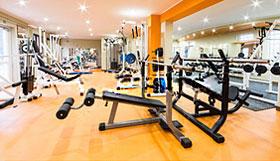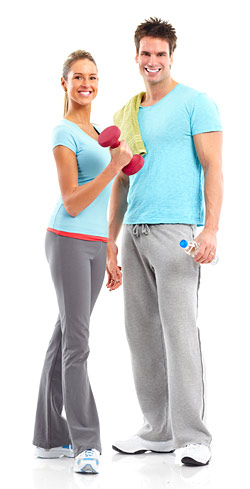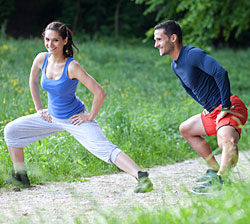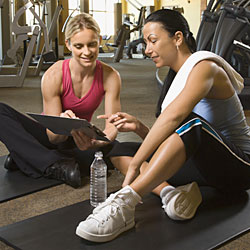- Like
- SHARE
- Digg
- Del
- Tumblr
- VKontakte
- Flattr
- Buffer
- Love This
- Save
- Odnoklassniki
- Meneame
- Blogger
- Amazon
- Yahoo Mail
- Gmail
- AOL
- Newsvine
- HackerNews
- Evernote
- MySpace
- Mail.ru
- Viadeo
- Line
- Comments
- Yummly
- SMS
- Viber
- Telegram
- JOIN
- Skype
- Facebook Messenger
- Kakao
- LiveJournal
- Yammer
- Edgar
- Fintel
- Mix
- Instapaper
- Copy Link
 Start Your New Fitness Lifestyle Off Right With These Tips and Guidelines
Start Your New Fitness Lifestyle Off Right With These Tips and Guidelines
So you’ve decided it’s time to start exercising. Congratulations on making one of the most important decisions you can make for your health and fitness! It takes courage to decide to start a fitness program when you are a beginner, and you should feel proud of yourself! It’s a lot easier to stay in old patterns than it is to embark upon something new, even if the new thing is clearly the healthy choice.
When you walk into a gym for the first time in a long time, or maybe the first time ever, it can be intimidating. Dozens of weight machines, cardio training machines, exercise balls, free weights, and more…and lots of sweaty people in various stages of fitness milling around. You might feel like you’re the only one who doesn’t know what they are doing. Don’t despair! It may take you a little while to start feeling comfortable, but with the right attitude and the right exercise program, you will start feeling AND seeing results before you know it.
I want to help set you up for ongoing fitness success! This article is meant as an orientation to help you get your bearings as you step into the wide world of fitness. We will go over some key points you’ll want to consider when starting an exercise program for the first time, such as talking to your doctor, choosing a gym, setting realistic expectations, the importance of nutrition, taking a balanced approach to exercising, what to include in your exercise program, and finally, what to look for when enlisting the help of a personal trainer.
Before You Begin, Consult Your Doctor
 When you’re beginning an exercise program, your safety should be your first priority. Exercise may be the best medicine, but if you have underlying health issues, the wrong types of exercise may do more harm than good. And nothing will halt your fitness progress faster than injuring yourself or triggering a health problem! If you have known or suspected health issues, it is vital to consult with your doctor before beginning any kind of exercise program.
When you’re beginning an exercise program, your safety should be your first priority. Exercise may be the best medicine, but if you have underlying health issues, the wrong types of exercise may do more harm than good. And nothing will halt your fitness progress faster than injuring yourself or triggering a health problem! If you have known or suspected health issues, it is vital to consult with your doctor before beginning any kind of exercise program.
The PAR-Q (Physical Activity Readiness Questionnaire) is a quick test you can use to screen yourself for possible problems affecting your health and your ability to exercise safely. The PAR-Q is commonly used by personal trainers to screen their clients. Even if you clear the PAR-Q, it’s still a good idea to get a physical exam before starting a fitness program to make sure you can safely exercise. If you answer yes to one or more questions on the PAR-Q, you ABSOLUTELY MUST consult with your doctor to find out which exercises you should and shouldn’t do.
Choose the Right Gym FOR YOU
 Of course, you don’t have to join a gym to get fit. But it’s usually the easiest and most convenient way of doing so. Ask for tours at several local gyms to find one that feels like a good match. Gyms vary widely in both what they offer and in their culture.
Of course, you don’t have to join a gym to get fit. But it’s usually the easiest and most convenient way of doing so. Ask for tours at several local gyms to find one that feels like a good match. Gyms vary widely in both what they offer and in their culture.
Consider what’s important to you. Would you like to take fitness classes? Maybe try yoga or Zumba? Meet friendly new people? Have access to qualified trainers and floor staff? Take showers onsite? Learn to play basketball/tennis/swim? Have 24-hour access to better suit your schedule? Ask your friends and family for recommendations and read online reviews. Everybody will vary in what they want from a gym, so keep in mind what’s important to you.
When you stop by a possible gym, if the gym manager or front desk person isn’t willing to spend some time giving you a tour and answering your questions about the facility, you can be sure it’s not a good gym and it’s time to check out the next one!
Set Realistic Expectations
 Whether your fitness goals are big or small, you need to start out with realistic expectations. Expecting light-speed weight loss or superhuman strength overnight or even within a few months is a mistake. You will feel demotivated if you set the bar too high too fast and fail to achieve your lofty goals. This will make you more likely to quit your exercise program before it has had a chance to work.
Whether your fitness goals are big or small, you need to start out with realistic expectations. Expecting light-speed weight loss or superhuman strength overnight or even within a few months is a mistake. You will feel demotivated if you set the bar too high too fast and fail to achieve your lofty goals. This will make you more likely to quit your exercise program before it has had a chance to work.
Say you want to lose 50 pounds. That is definitely something you can do, but it will not happen overnight. A realistic weight loss goal is 0.5 to 2 pounds per week. The age-old adage “slow and steady wins the race” couldn’t be more true regarding weight loss. Faster weight loss than that is neither healthy nor sustainable.
Give yourself time and the weight loss will last rather than bouncing back. A fad diet combined with excessive exercise is one of many terrible ways to lose excess weight. When people lose weight quickly in this way, they are most often losing nothing but water weight, muscle glycogen, and muscle tissue. The weight is very likely to come back. Additionally, they will burn themselves out quickly from the excessive exercise their body isn’t prepared for. At the best, they will feel defeated and demotivated, and at the worst, they will end up injuring themselves or aggravating underlying health issues.
Eat to Nourish Your Body and Fuel Your Exercise Program
 A sedentary history is often accompanied by some not-so-great eating habits. Please know that getting your nutrition in line is one of the most important steps to achieving better health and fitness. Have you ever heard the saying “you can’t out-train a bad diet”? It’s true for advanced athletes, and it’s just as true for beginning exercisers. I see lots of people justify very bad food choices with the excuse, “oh, it’s OK because I worked out today.” Sorry, it’s still not OK. I’ve been there myself, and so have many of my clients! You will sabotage your efforts at weight loss and strength gain if you don’t eat right. Moreover, without proper fuel, you won’t have the energy to follow your exercise program.
A sedentary history is often accompanied by some not-so-great eating habits. Please know that getting your nutrition in line is one of the most important steps to achieving better health and fitness. Have you ever heard the saying “you can’t out-train a bad diet”? It’s true for advanced athletes, and it’s just as true for beginning exercisers. I see lots of people justify very bad food choices with the excuse, “oh, it’s OK because I worked out today.” Sorry, it’s still not OK. I’ve been there myself, and so have many of my clients! You will sabotage your efforts at weight loss and strength gain if you don’t eat right. Moreover, without proper fuel, you won’t have the energy to follow your exercise program.
Nutrition isn’t one-size-fits-all, and the point of this article isn’t to explore the ins and outs of fitness nutrition. I just want to bring your attention to the fact that you cannot overlook nutrition and expect to see results. Here are some quick nutrition tips that you can start using right away:
- Avoid fad diets and supplements promising quick weight loss
- Eat whole foods as much as possible (foods recognizable in their original form)
- Be wise about portion size
- Cut down on sugar and processed foods of all kinds
- Eat a balanced breakfast that includes protein, carbohydrates, and “good” fats
- Limit your caffeine intake
- Get an allergy test to see if you have any underlying food allergies or sensitivities
If you need help getting your eating on track, or understanding healthy eating, your best course of action is to hire a nutritionist or a registered dietician, or at the very least a personal trainer with a specialty nutrition credential.
It’s also helpful to track your eating using an old-fashioned food diary or better yet, a smartphone app that allows you to do so on the go from your phone. Look into MyFitnessPal, MyNetDiary, and Weight Watchers. This will help you get into good habits by making you more accountable for your food choices.
Take a Balanced Approach to Exercise
 There are several components to a balanced exercise program. Men and women of all ages should integrate these components into their workout routines. It will look different for everyone, but here are the broad categories with example activities:
There are several components to a balanced exercise program. Men and women of all ages should integrate these components into their workout routines. It will look different for everyone, but here are the broad categories with example activities:
- Cardio Fitness: Activities that raise your heart rate and improve the strength and endurance of your cardiorespiratory system (examples: walking, jogging, aerobics, cycling)
- Full-Body Stability: Training the core and the limbs to work efficiently and safely to stabilize the body, especially the lumbar spine (examples: core training, yoga, Pilates)
- Muscular Strength and Endurance: The ability of your skeletal muscles to produce force and continue doing so (examples: weight lifting, body toning classes, Pilates)
- Flexibility: The freedom to move each joint through its full and proper range of motion (examples: stretching, self-myofascial release, yoga)
- Balance: Maintaining the body’s equilibrium both during static postures and during movements (examples: balance drills, Tai Chi, yoga, QiGong). This is especially important for older people, as improving the balance greatly reduces the risk of falling.
Everyone will have certain aspects they enjoy more than others, but it’s a mistake to neglect any of the aspects. You’ll see the best and most sustainable results when you integrate these components. For example, I meet many women who are afraid to lift weights, thinking that they will get bulky like a bodybuilder. The truth is that strength training is usually the missing link in efficient and effective weight loss among women! Remember that muscle is hungry: the more active your muscle tissue, the more calories you will burn both during exercise and at rest.
And not to let men off the hook: I know lots and lots of guys who like to skip out on the flexibility component. They will do their cardio and of course their weights, only to get tighter and stiffer, eventually injuring themselves and exacerbating posture issues.
Remember that a balanced body is a healthy and fit body!
Have Fun!
 Unless you’re a glutton for punishment, if you hate your exercise program, you won’t do it, and it won’t work! Breaking into the exercise world after years of being sedentary is no walk in the park (so to speak), so expect it to be somewhat uncomfortable at first.
Unless you’re a glutton for punishment, if you hate your exercise program, you won’t do it, and it won’t work! Breaking into the exercise world after years of being sedentary is no walk in the park (so to speak), so expect it to be somewhat uncomfortable at first.
You may feel sore and tired when you’re first starting out. That is normal. There may be times when you feel discouraged and demotivated. That’s normal too! Just keep pushing ahead. At some point, it WILL begin to feel easier. You should always be challenging yourself to improve, but the more exercise becomes part of your life, the more natural and “easy” it will feel.
Do yourself a favor and find ways to make exercising more enjoyable for yourself from the very beginning. Here is a list of ideas that have worked for me and/or my clients:
- Try an exercise class such as yoga, Zumba, or body toning (talk to the instructor first to make sure it’s an appropriate choice for a beginner)
- Be friendly and open with other exercisers to increase the social component
- Work out with a friend or family member with similar goals
- Motivate yourself with music (get a portable mp3 player or an armband to hold your smartphone)
- Listen to audiobooks or podcasts
- Wear exercise clothes that make you feel good (try TJ Maxx or Ross for affordable choices)
- Reward yourself for completed workouts (NOT with unhealthy foods, though!)
Keep the Motivation Going
 Making sure exercise is at least somewhat fun is one of the best ways to stay motivated. But there are other “not-as-fun” but still important strategies you can use to keep your motivation alive. These include:
Making sure exercise is at least somewhat fun is one of the best ways to stay motivated. But there are other “not-as-fun” but still important strategies you can use to keep your motivation alive. These include:
- Keeping a workout log (there are lots of smartphone apps for this)
- Post a workout calendar on your fridge and check off each day as you go
- Tracking your eating habits with a food log (again, lots of great apps out there)
- Taking before-and-after pictures and measurements so you can see where you started
- Making yourself accountable: share your goals with family and friends and ask them to support you and help keep you on track
Consider Hiring a Personal Trainer
 I hope this article has helped get you started down the path toward success, but the best thing to do when you’re beginning an exercise program is to work with a personal trainer. A trainer will demystify your beginning fitness program far better than anything else, making sure you are exercising safely, efficiently, and effectively. Think how much time and energy you might be wasting on ineffective or even dangerous exercises!
I hope this article has helped get you started down the path toward success, but the best thing to do when you’re beginning an exercise program is to work with a personal trainer. A trainer will demystify your beginning fitness program far better than anything else, making sure you are exercising safely, efficiently, and effectively. Think how much time and energy you might be wasting on ineffective or even dangerous exercises!
Many people have the misconception that working with a trainer is prohibitively expensive. This doesn’t have to be true! I myself work with many clients on a budget, including college students and seniors on a fixed income. What I will do with beginning folks on a budget is a full fitness assessment and then two follow up sessions for workout instruction. Then we meet again twice every 6 weeks or so to check on progress and cycle into the next phase of training.
Call around to trainers in your area and ask if they can do something similar. Make sure the trainer you choose is well-qualified.
Choose a personal trainer who:
- Has a certification from a respected certifying agency such as NASM, ACE, ACSM, and NSCA
- Has specialty credentials or experience working with people of your age group, sex, fitness goals, etc.
- Has college degree in a related field (not always necessary, but helpful)
- Is patient, respectful, and friendly…and is someone you like!
- Feels like a good match with you personality wise (someone could be a great trainer but a bad fit for you!)
Here are some more key qualities to look for when hiring a personal trainer.
The Bottom Line
I hope this article has helped you get your bearings as you begin your new healthy lifestyle. One take-away point that I really want you to remember is that EVERYONE is a beginner at some point. Some people have been exercising since childhood, but this is NOT true for everybody…even many personal trainers, such as myself, didn’t begin a structured exercise program until adulthood. You don’t need to be perfect to get started. I know it’s easier said than done, but try to check any perfectionism at the door.
There will be times when you backslide. There will be the occasional fast food binge and skipped workout. There will be times you feel like giving up. DON’T GIVE UP! Be patient and forgiving with yourself while you adapt to living your new life. Be as consistent as possible. And remember to have fun and enjoy the journey!
Stay tuned for forthcoming articles by Mae in the Beginner’s Guide to Exercise Series. Subscribe to the AskTheTrainer.com Blog to get our latest articles delivered to your inbox, spam-free!
About Mae Barraclough
Mae Barraclough, B.S., NASM-CPT, NASM-CES is a certified personal trainer, corrective exercise specialist, and licensed Zumba Instructor. With her passion for health, fitness, and dance, Mae loves learning all she can and sharing her knowledge with others.

